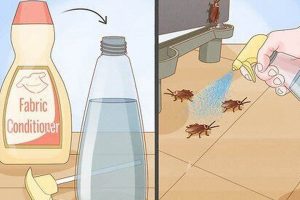The construction of homemade devices intended to capture rodents involves utilizing readily available materials and simple mechanics. An example of this is a bucket trap, employing a rotating cylinder smeared with bait to induce the rodent to fall into the container.
Creating these devices can offer several advantages, including cost-effectiveness and the ability to tailor the trap’s design to specific environments or rodent species. Historically, such methods were crucial for pest control in areas with limited access to commercially produced traps.
The subsequent discussion will explore various designs for constructing such devices, safety considerations, and best practices for deploying these solutions to effectively manage rodent populations.
DIY Rodent Trap Tips
Effective construction and deployment of rodent capture devices require careful attention to detail and a comprehensive understanding of rodent behavior. The following tips aim to optimize the success of these endeavors.
Tip 1: Bait Selection. Employing appropriate bait is critical. Rodents are often attracted to foods high in fat and sugar. Peanut butter, seeds, or nuts are generally effective. Consider placing a small quantity of the chosen bait in the intended capture area for several days prior to setting the device to acclimate the rodents.
Tip 2: Location is Paramount. Identify areas with high rodent activity. Look for signs such as droppings, gnaw marks, or nesting materials. Place the device in these locations, prioritizing areas along walls, behind appliances, and in dark, secluded corners.
Tip 3: Camouflage and Stabilization. Conceal the device to increase its effectiveness. Utilizing natural materials such as leaves, dirt, or cardboard can help the device blend into its surroundings. Ensure the device is stable and will not tip over prematurely.
Tip 4: Safety Precautions. When constructing and handling these devices, wear gloves to minimize the risk of disease transmission. After capturing a rodent, dispose of the device and the captured animal responsibly. Check local regulations regarding disposal methods.
Tip 5: Trap Maintenance. Regularly inspect the device. Remove any decaying bait and replace it with fresh bait. Clean the device periodically to eliminate odors that may deter subsequent captures. Reset the device promptly after a successful capture.
Tip 6: Multiple Deployments. Deploy multiple devices simultaneously in areas with significant rodent populations. This increases the likelihood of capturing a larger number of rodents in a shorter period.
Tip 7: Preventative Measures. Complementing capture efforts with preventative measures is crucial. Seal entry points in the building’s structure, eliminate food sources, and maintain a clean environment to reduce the likelihood of future infestations.
By adhering to these guidelines, the efficacy of self-constructed rodent capture devices can be significantly enhanced, contributing to effective and sustainable rodent management.
The subsequent sections will address the advantages and disadvantages of constructing these devices, as well as ethical considerations related to rodent control.
1. Material Selection
Material selection constitutes a foundational element in the effective design and construction of rodent capture devices. The properties inherent in chosen materials directly influence trap durability, functionality, and overall success rate. Inappropriate material choices can lead to premature failure, reduced capture efficiency, or even pose safety hazards.
- Durability and Longevity
The selected material must withstand environmental stressors and physical interactions with rodents. For instance, traps constructed from untreated cardboard exhibit limited longevity, particularly in humid environments, and are easily compromised by gnawing. Conversely, durable materials like metal or treated wood offer extended service life, enabling repeated use and reducing the need for frequent replacement.
- Material Cost and Availability
The cost of materials impacts the overall economic viability of DIY rodent control. Readily available and inexpensive materials, such as plastic buckets or repurposed containers, facilitate widespread deployment without significant financial burden. In contrast, specialized or costly materials may restrict accessibility and limit the scalability of trapping efforts.
- Rodent Interaction and Detectability
Rodents exhibit varying responses to different materials. Some materials may emit odors or textures that deter rodent approach, while others may provide enhanced grip or concealment. For example, smooth, slippery surfaces, such as those found on certain plastics, can hinder a rodent’s ability to escape a trap, thereby increasing capture success. Conversely, easily chewed materials may allow rodents to dismantle the trap or access bait without triggering the capture mechanism.
- Safety and Toxicity
Material safety is paramount, particularly in environments where children or pets may be present. The utilization of non-toxic materials is crucial to prevent accidental poisoning or other adverse health effects. Avoidance of materials treated with pesticides or hazardous chemicals is essential to ensure the safety of both the target rodents and non-target organisms.
The interplay of these factors underscores the critical role of informed material selection in the successful deployment of homemade rodent capture devices. By carefully considering durability, cost, rodent interaction, and safety, individuals can optimize trap performance and enhance the effectiveness of their rodent control strategies. Alternative materials, such as specific types of wood versus certain plastics, present trade-offs that require careful evaluation based on the specific context and objectives of the trapping effort.
2. Construction Simplicity
Construction simplicity directly influences the accessibility and efficacy of homemade rodent capture devices. A design requiring specialized tools, extensive technical knowledge, or rare components hinders widespread adoption and practical application. The core principle of a self-constructed trap lies in its attainability and ease of replication using readily available resources. For example, a simple snap trap mechanism crafted from wood and wire, requiring minimal carpentry skills, exemplifies effective simplicity. Conversely, a trap incorporating complex electronic components or intricate mechanical assemblies would deter most users due to the increased difficulty and cost.
The importance of construction simplicity extends beyond initial assembly. Simplified designs facilitate easier maintenance, repair, and bait replacement. A trap that can be quickly disassembled a
nd reassembled allows for efficient cleaning, reducing the risk of disease transmission and prolonging the device’s lifespan. Furthermore, a straightforward mechanism allows for rapid diagnosis and correction of malfunctions, ensuring consistent operational effectiveness. An instance highlighting practical significance involves a bucket trap with a simple pivoting plank. Its uncomplicated construction allows for quick resetting after each capture, maximizing its usefulness in areas with high rodent activity.
In summary, construction simplicity is a critical determinant of the overall utility and sustainability of homemade rodent capture solutions. Its influence extends from ease of initial creation to long-term maintenance and repair, ensuring accessibility and practical applicability. While more complex designs might offer theoretical advantages, the inherent benefits of a simple, easily replicable approach outweigh the potential gains in specialized functions. Understanding the connection between construction simplicity and the efficacy of homemade rodent capture mechanisms is fundamental for effective pest management.
3. Bait effectiveness
Bait effectiveness is a pivotal element in the operational success of self-constructed rodent capture devices. The type and presentation of bait directly influence the likelihood of attracting rodents to the trap and triggering the capture mechanism. Inadequate bait selection negates the mechanical advantages of even the most sophisticated DIY trap design. For instance, a well-constructed bucket trap becomes ineffective if it contains bait that does not appeal to the local rodent population.
The selection of appropriate bait necessitates an understanding of rodent dietary preferences within a specific geographic area. Commonly used baits include peanut butter, seeds, nuts, and grains. The attractiveness of these baits can be enhanced by adding flavoring agents such as chocolate or vanilla extract. Placement of the bait within the trap is also crucial. The bait should be positioned to encourage the rodent to fully enter the trap, ensuring activation of the trapping mechanism. Furthermore, the freshness and quality of the bait directly impact its appeal; stale or contaminated bait is less likely to attract rodents.
In conclusion, bait effectiveness is inextricably linked to the success of do-it-yourself rodent control strategies. The careful selection, preparation, and placement of bait are essential for maximizing trap efficiency and minimizing the persistence of rodent infestations. The practical significance of understanding this connection resides in the ability to optimize trap performance and improve the overall efficacy of homemade rodent control solutions.
4. Placement strategy
Placement strategy constitutes a critical determinant in the efficacy of homemade rodent capture devices. The location of a trap significantly influences the likelihood of rodent interaction, directly impacting capture rates. Ineffective placement undermines the effectiveness of even the most meticulously constructed trap. For instance, a trap placed in an open area with minimal rodent activity yields negligible results, irrespective of its design or bait effectiveness.
Rodents exhibit predictable patterns of movement and habitation. Prioritizing locations along walls, behind appliances, and in dark, secluded corners maximizes the probability of intercepting rodents traveling established routes. Identifying areas exhibiting signs of rodent activity, such as droppings, gnaw marks, or nesting materials, further refines trap placement. The positioning of the trap in relation to potential food sources also influences its attractiveness. A trap placed near a readily accessible food source is less likely to attract rodents than one positioned further away, forcing the rodents to actively seek sustenance.
In conclusion, a well-defined placement strategy is indispensable for successful do-it-yourself rodent control. Careful consideration of rodent behavior, habitat preferences, and food source proximity is essential for optimizing trap location and maximizing capture rates. Understanding the correlation between placement strategy and the functionality of homemade rodent capture devices is vital for achieving effective and sustainable rodent management.
5. Humane disposal
Humane disposal represents a critical ethical consideration in the context of constructing and deploying homemade rodent capture devices. The objective shifts beyond mere elimination of the pest to encompass the minimization of suffering and the responsible management of captured animals. This necessitates careful deliberation regarding both the design of the capture device and the methods employed for euthanizing captured rodents.
- Trap Design Considerations
The design of the capture device directly impacts the potential for causing unnecessary pain or stress to the rodent. Traps designed for instant killing, such as certain snap traps, are generally considered more humane than live traps if they function as intended. However, the effectiveness of instant-kill traps depends on proper maintenance and sufficient force to ensure a swift and decisive death. Live traps, while often perceived as more humane, necessitate a predetermined plan for euthanasia, as prolonged confinement can induce significant stress and suffering.
- Euthanasia Methods
When live traps are employed, the selection of a humane euthanasia method is paramount. Acceptable methods typically involve inducing rapid unconsciousness followed by cessation of vital functions. Carbon dioxide asphyxiation, when performed correctly, is considered a relatively humane option. Drowning, blunt force trauma, and the release of captured rodents into unfamiliar environments are generally considered inhumane due to the prolonged suffering or potential for starvation and predation they inflict.
- Legal and Ethical Ramifications
The treatment of captured rodents may be subject to legal regulations and ethical guidelines. Some jurisdictions may have specific laws governing the permissible methods of rodent control and euthanasia. Moreover, personal ethical beliefs often influence the choice of disposal methods, with many individuals prioritizing the minimization of animal suffering, regardless of legal mandates. The implementation of humane disposal practices reflects a commitment to responsible pest management.
- Practical Challenges
The practical implementation of humane disposal methods can present challenges. Ensuring a swift and painless death requires precision and careful execution. Furthermore, emotional considerations can make it difficult for some individuals to perform euthanasia themselves. In such cases, seeking assistance from a professional pest control service or animal welfare organization may be a more appropriate course of action. The decision to engage a professional should be weighed against the potential for prolonged suffering if euthanasia is delayed or performed improperly.
The convergence of these facets underscores the ethical responsibility inherent in deploying homemade rodent capture devices. While the o
bjective remains rodent control, the methods employed must prioritize the minimization of suffering and the responsible management of captured animals. Humane disposal is not merely a secondary consideration but an integral component of a comprehensive and ethical pest management strategy.
6. Cost efficiency
The economic considerations inherent in rodent control strategies necessitate an evaluation of cost-effectiveness. The construction and deployment of self-made rodent capture devices represent a potentially cost-efficient alternative to professional pest control services or commercially manufactured traps. This analysis examines the components of cost efficiency within the framework of “diy rodent trap” solutions.
- Reduced Material Expenditure
Construction of homemade traps often leverages readily available and inexpensive materials, such as buckets, scrap wood, and common household items. This contrasts with the purchase of commercially produced traps, which can represent a significant upfront expense. The ability to repurpose existing materials further minimizes the financial investment required for rodent control.
- Elimination of Service Fees
Engaging professional pest control services entails recurring service fees, including inspection, treatment, and follow-up visits. The deployment of self-made traps eliminates these ongoing costs, offering a fixed-cost solution for rodent management. This advantage is particularly relevant for property owners facing persistent or recurring infestations.
- Scalability and Adaptability
The construction of homemade traps allows for scalability based on the severity of the infestation. Multiple traps can be easily fabricated and deployed at minimal cost, enabling comprehensive coverage of affected areas. Furthermore, the design of self-made traps can be adapted to specific environments or rodent species, optimizing capture effectiveness without incurring additional expenses.
- Long-Term Cost Savings
While the initial investment in materials and construction time may be minimal, the long-term cost savings associated with self-made traps can be substantial. Unlike chemical rodenticides, which require repeated application and pose environmental risks, homemade traps offer a sustainable and cost-effective solution for ongoing rodent control. The durability of well-constructed traps further contributes to long-term economic benefits.
In summation, the cost efficiency of “diy rodent trap” solutions stems from the reduced material expenditure, elimination of service fees, scalability, and long-term cost savings. These factors collectively contribute to a financially viable and sustainable approach to rodent management, particularly for individuals seeking alternatives to professional pest control services or commercially produced traps.
7. Preventative integration
Effective rodent management necessitates a holistic approach encompassing both reactive measures, such as homemade capture devices, and proactive preventative strategies. The integration of preventative measures alongside “diy rodent trap” methods significantly enhances long-term control and reduces the reliance on reactive interventions.
- Building Envelope Integrity
Maintaining the structural integrity of the building envelope is paramount. Sealing cracks and crevices in foundations, walls, and roofs denies rodents access points. Examples include caulking gaps around pipes, installing door sweeps, and repairing damaged screens. Neglecting these measures renders “diy rodent trap” efforts less effective, as rodents continually re-enter the structure.
- Sanitation and Food Storage Practices
Eliminating food sources is crucial for preventing rodent infestations. Proper storage of food in airtight containers, regular cleaning of spills and crumbs, and secure disposal of garbage reduce attractants. Failure to address these factors sustains rodent populations, diminishing the long-term impact of “diy rodent trap” strategies.
- Vegetation Management
Controlling vegetation around the perimeter of the building reduces harborage opportunities for rodents. Trimming bushes and shrubs away from walls, removing debris piles, and maintaining a clear zone around the foundation limit potential nesting sites. Unmanaged vegetation provides cover and nesting material, negating the benefits of “diy rodent trap” deployment.
- Drainage and Moisture Control
Addressing drainage issues and managing moisture levels minimizes favorable conditions for rodents. Repairing leaky pipes, ensuring proper drainage away from the foundation, and reducing standing water eliminate sources of water and humidity that attract rodents. Uncontrolled moisture creates conducive environments for rodent survival, undermining “diy rodent trap” efforts.
The synergistic effect of combining these preventative measures with “diy rodent trap” tactics fosters a sustainable rodent control strategy. While homemade traps address existing infestations, preventative integration proactively minimizes the likelihood of future incursions, resulting in a more effective and economically sound approach to rodent management.
Frequently Asked Questions
This section addresses common inquiries regarding the construction, deployment, and efficacy of self-made rodent capture devices, providing factual information and dispelling potential misconceptions.
Question 1: What materials are most effective for constructing durable rodent traps?
Durable traps necessitate materials resistant to gnawing and environmental degradation. Pressure-treated lumber, galvanized steel mesh, and robust plastics exhibit superior longevity compared to cardboard or untreated wood. Material selection should balance durability with cost and ease of manipulation.
Question 2: How does bait selection impact the success rate of homemade rodent traps?
Bait effectiveness is paramount. Rodents exhibit preferences for high-fat and high-carbohydrate foods. Peanut butter, sunflower seeds, and bacon grease often prove effective. Bait should be fresh, securely affixed within the trap, and positioned to encourage complete entry.
Question 3: What are the ethical considerations regarding the use of lethal versus live rodent traps?
Lethal traps, if designed and maintained correctly, aim for instantaneous killing, minimizing suffering. Live traps necessitate a humane euthanasia plan. Releasing captured rodents is generally discouraged due to the potential for ecological disruption and the likelihood of the animal’s demise due to starvation or predation.
Question 4: What are the most common mistakes in placing homemade rodent traps, and how can these be avoided?
Common errors include placing traps in open areas, failing to secure the trap, and neglecting to pre-bait the area. Traps should be positioned along walls, in dark corners, and in areas exhibiting signs of rodent activity. Pre-baiting familiarizes rodents with the trap location.
Question 5: How can preventative measures enhance the effectiveness of “diy rodent trap” strategies?
Pr
eventative measures are integral to sustained control. Sealing entry points, eliminating food sources, and maintaining a clean environment reduce rodent attractants. Addressing underlying issues diminishes reliance on traps as the sole control method.
Question 6: Are there any legal restrictions regarding the construction and deployment of rodent traps?
Local regulations may govern the permissible methods of rodent control and the handling of captured animals. Prior to deploying traps, it is prudent to consult local ordinances and animal control agencies to ensure compliance with applicable laws.
In summation, successful utilization of self-constructed rodent capture devices hinges on informed decision-making, ethical considerations, and adherence to best practices. Understanding the interplay of material selection, bait effectiveness, placement strategy, and preventative integration is essential for achieving sustained rodent control.
The following section will address potential challenges and troubleshooting strategies associated with “diy rodent trap” solutions.
Conclusion
The preceding analysis explored various facets of “diy rodent trap” methodologies, encompassing construction materials, bait selection, deployment strategies, and ethical considerations. Effective implementation requires a comprehensive understanding of rodent behavior and a commitment to responsible pest management practices. While offering a potentially cost-effective alternative to professional services, the efficacy of self-constructed devices hinges on meticulous planning and execution.
The long-term success of rodent control efforts necessitates a proactive integration of preventative measures to minimize future infestations. Continued diligence in sanitation, building maintenance, and responsible waste management remains paramount in mitigating the economic and health-related consequences of rodent populations.







